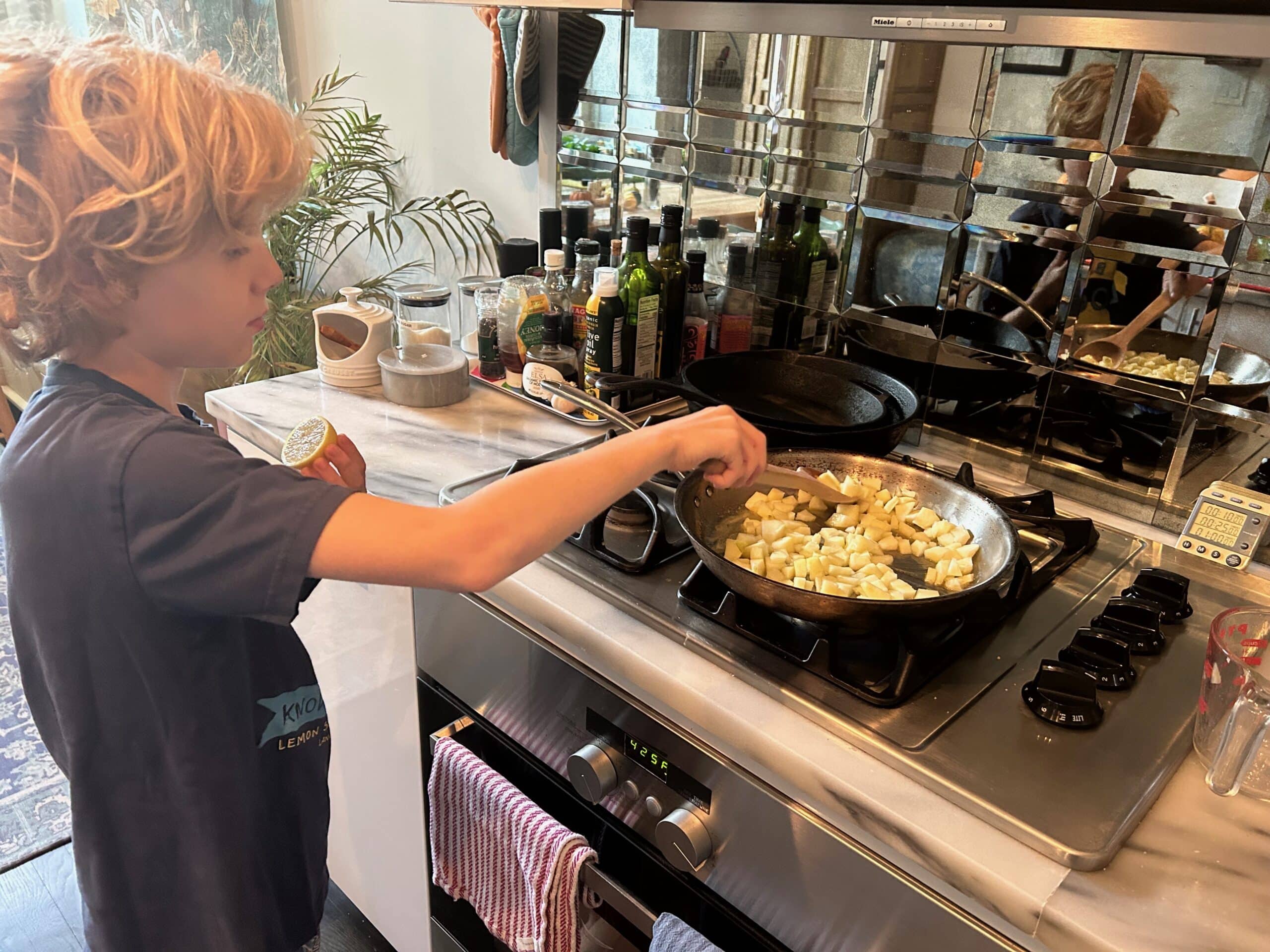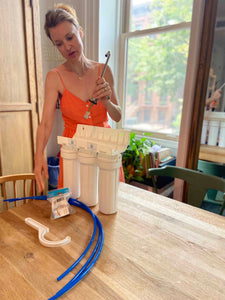Types of Toxic & Non-Toxic Cookware
Pots and pans come in a wide range of materials. Some cookware materials are okay, if you have the right variety, or if you don’t use them every day. Let’s go through these one by one, including the brands we recommend.
Nontoxic Cookware Materials
The following materials are always non-toxic. We will share our favorite brands made of these materials below, under The Best Stuff.
Carbon Steel
Carbon steel is sometimes used for frying pans and woks. It’s similar to cast iron, and can leach small amounts of iron into food, which is great if you have someone with slight anemia in your home!
Cast Iron
For most of human history, people suffered from iron deficiencies, so cooking with cast iron helped to prevent anemia. In modern cultures, the opposite is true. Most of us get plenty of iron, and there’s a point at which ingesting too much can be problematic. In our kitchen, we try to switch between cast iron pans and pans made of other materials throughout the week. If you want to be extra cautious, you could avoid cast iron for recipes with long cooking duration or acidic foods, as this will cause increased iron leaching.
Stainless Steel
Stainless steel pans are generally Good Stuff. The only caveat here is that stainless steel is made with nickel (the more nickel in the mix, the more “stainless” it is). The problem is that our bodies can handle some nickel, but too much isn’t healthy. This means that high quality stainless steel cookware, which has higher percentages of nickel, is actually of more concern than lower quality stainless steel! We know that stainless steel pans do leach nickel (along with some chromium and iron), especially with longer cooking times and when cooking acidic foods such as tomatoes. To minimize the potential for nickel leaching, you’d ideally want a pan that’s 18/4 or 18/0 stainless steel (that first number is the percentage of chromium; the second is nickel). I wouldn’t be concerned about using stainless steel as long as you just switch up your cookware. If you sometimes using cast iron and enamel pots and pans, you won’t be exposing yourself to too much nickel from stainless steel. If you’re still worried, you could avoid stainless steel when cooking acidic foods for long time periods.
Tempered Glass
Glass is probably the most inert of any cooking surface, and you can even get pots and pans made of this ultimate Good Stuff!
Titanium
Titanium is a non-toxic and biocompatible metal, so it is used for medical instruments, dental implant devices, and joint replacements. Titanium is also lightweight and extremely strong. Titanium cookware uses an aluminum base for even heat transfer and distribution. The non-porous, non-stick titanium outer surface does not allow any aluminum to leach through. The only reason to be cautious about titanium cookware is that it seems that most manufacturers now coat their titanium cookware with non-stick finishes, rendering it “Bad Stuff.”
Materials That May Be Safe in Cookware
When shopping for non-toxic cookware, some of these materials come in safe forms. Other times, they are treated (or untreated, as the case may be) in a way that renders them less safe.
Clay
Without testing a clay pot for every possible contaminant, you have no way of knowing what might be leaching into your food. Without a glaze on the pot, there is no protective barrier between what’s in the clay and your meal. The risks of unglazed clay pots and pans outweigh the potential benefits of the good minerals that might leach into your food—calcium, iron, etc.
Coated Ceramic
Made from natural materials such as clay and minerals, ceramic cookware offers excellent heat retention and distribution. Its non-reactive surface makes it ideal for cooking acidic foods, and it is also appreciated for its nontoxic nonstick cookware properties, requiring less oil or fat during cooking. Furthermore, it is generally considered safer than nonstick alternatives since it doesn’t contain potentially harmful chemicals like PFOA or PTFE. Ceramic cookware can be considered a safe less-stick if not truly truly non-stick material. Some ceramic cookware is coated with materials that may contain harmful substances like lead, cadmium, and other heavy metals. To ensure safety, it is crucial to choose ceramic cookware that is labeled as free from toxic materials and is certified as being compliant with safety standards.
Enamel
In essence, enamel is a form of glass. Enameled cookware is most often cast iron with an enamel coating. This type of cookware is wonderful to cook with. Some people have worried about lead in the enamel cookware, since the enamel coating is often made of clay, which can leach lead. For this reason, we suggest choosing high quality enamel cookware from well-known brands.
Materials to Avoid in Cookware
The following materials are always unsafe when used for cookware. You’ll learn more about how to avoid them under the Bad Stuff and Sneaky Stuff, below. Look for cookware brands that they have tested under limits for California Prop 65 for more peace of mind.
- Aluminum
- Copper
- Nonstick/Teflon
- Plastic








































247 comments
Anjali
What are your thoughts on stovetop tea kettles made of borosilicate glass? For instance the medelco one: https://www.amazon.com/Medelco-12-Cup-Stovetop-Whistling-Kettle/dp/B000V5X826
I bought the Staub kettle you recommended and like everything about it except the handles get too hot to use without a cloth and it is veryyyyy heavy. I thought about returning it and getting a glass tea kettle if it is as safe as ceramic
Bill
I’m not so sure Xtrema is as safe as it’s portrayed. The idea that it contains lead, even if it doesn’t leach, is off-putting: http://tamararubin.com/2017/06/mercola_pan/
I think CorningWare Pyroceram may be the best option. I ordered mine but they haven’t arrived yet (I also wish I could get Pyroceram lids for it instead of Pyrex).Jaime
Did you ever get a response to this. I’m interested in scanpan too! What did you end up purchasing?
Jennifer
I just used my self cleaning stove for the first time. I had the windows open but it still smelled and I had my 18 month old home. I’m assuming it’s covered in Teflon which is toxic. I should have done my research first and now I’m in a panic. Is one time enough to do major damage to my baby’s lungs? I’m always worried about cancer risks and now I’m really worried!
John Goss
Hi Andrea,
Renaware appears to have an 18/0 Stainless exterior covering an aluminum core. 18/0 stainless is fine as long as it does not wear through to the aluminum core.
Ana Jiménez
Hello,
what do you think about the SILIT brand for cooking? Their pots contain a pottery that they make called silargan. And the pans of the WMF brand with ceradur? Both are German brands and are made of ceramic. Do not recommend them?
Thank you very much.
I live in Spain and I follow your page. What do you recommend, because there are things I can not buy here
Andrea
Hi Maia-
What do you think about Rena Ware cookware? Is it safe to use? My mother has always used them and keeps insisting they are great! I did a little research and it seems it’s mainly stainless steel and aluminum, but I’m not sure if it’s good or sneaky stuff. Here is their website https://renaware.com/product-category/cookware/ but I found more info here: http://training.renaware.com/Thailand/PDFs/Product_Resources/English/1921_01_0711_Cookware.pdf Thank you for all your valuable information. :)Mat
Hello Maia
Thank you for gathering and sharing all this useful info in order to help us all. Just wanted to bring something to your attention after reading the bit on Greenpan. The material they use is silicon (SiO2) not silicone. Hope this helps with some of your research :) MatJohn
Hi Rebeca,
Grades of Stainless steel Flatware and Cookware - Economy grade Kitchenware in India is made with low carbon 14/1 (Chromium: 14%, Nickel: 1%) stainless steel - Economy grade 21/0 is used to make economy flatware. It is comparable to classic 18/0. Neither 21/0, nor 18/0 has any Nickel. ThanksJohn here…
20/0 has no nickel. This means that it is “Economy” grade cookware. From a health perspective, Economy grade (less nickel) is a good thing. It is interesting that, in the case of stainless cookware, the lower priced stuff is often the healthier choice!
John
Hi Harvey,
Thanks, JohnAluminum that is clad with Stainless is fine as long as the stainless is not scared through to the aluminum on the inside. Older/heavily-used clad pans can have this problem, but it takes a long time to wear through.